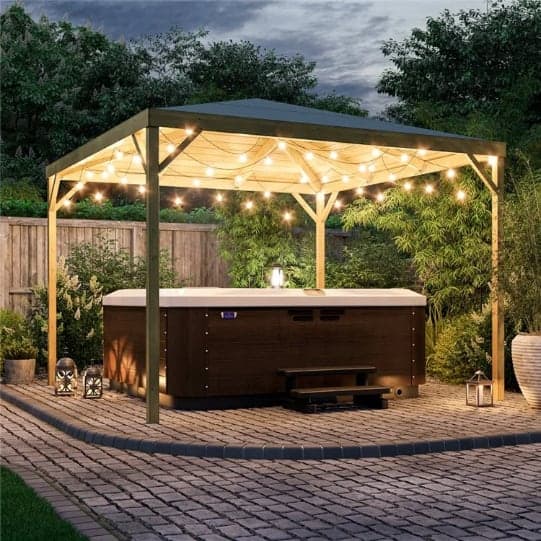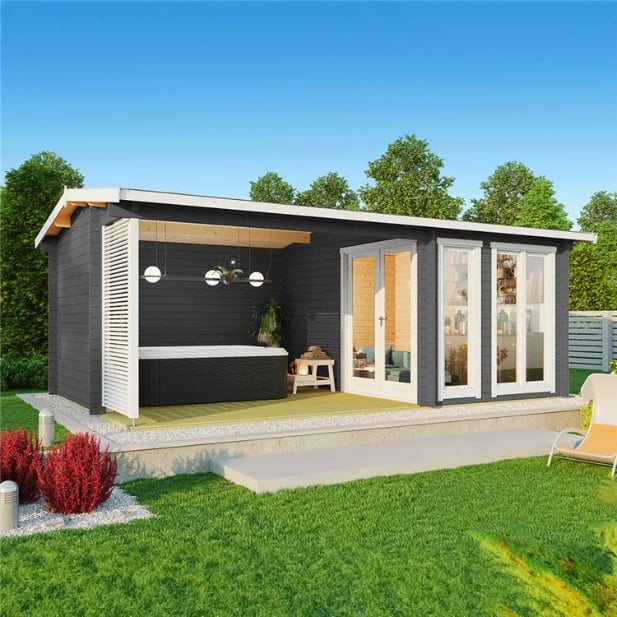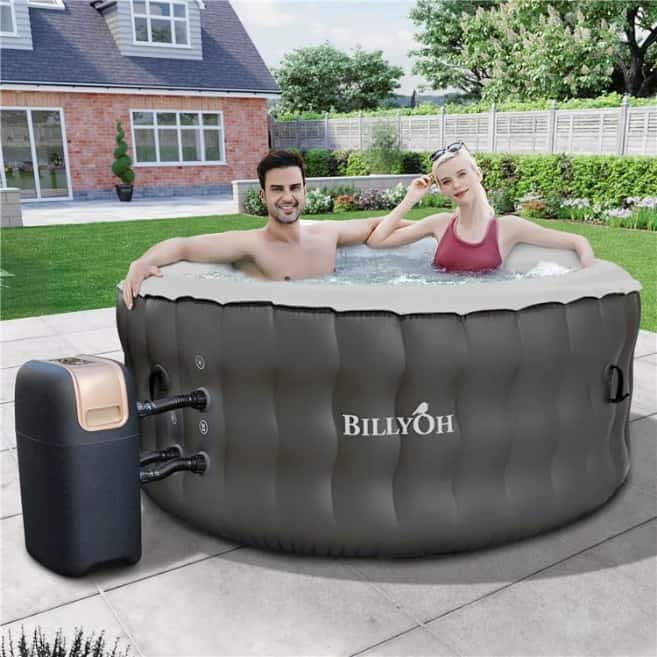Jump to:
Transforming your outdoor area into a cosy spot for your inflatable hot tub is what we’re all about. Think of it like creating a special hideaway where you can relax and unwind. In this guide, we’ll cover everything you need to know to make it happen. Let’s make sure your outdoor soak is not just fun but also super relaxing, shall we?
Choose Your Structure
When choosing a structure for your hot tub retreat, you have several options to consider:
Each has its unique features and advantages tailored to different preferences and needs.
Gazebos

Gazebos are freestanding structures with a roof and open sides, often made of wood or metal. They provide excellent shelter and can accommodate various sizes of hot tubs. With a classic and elegant look, a wooden gazebo, for one, creates an intimate space for relaxation. Moreover, the open design of a gazebo allows for ample ventilation. It’s perfect for enjoying the outdoors while soaking in your hot tub.
Note: Consider the risk of mould, rot, and decay due to water exposure, especially with a timber gazebo. Apply a waterproof sealant regularly to protect the wood. Ensure proper ventilation to prevent moisture buildup and prolong the gazebo’s lifespan. A metal gazebo is a great alternative for people interested in a more modern-styled structure.
Pergolas
Pergolas, in contrast, are structures with an open roof supported by columns or posts. They offer partial shade and can be adorned with climbing plants or fabric for added privacy. Pergolas provide a more open and airy feel compared to gazebos. This, in turn, makes them ideal for those who prefer a lighter and more spacious atmosphere. They also offer flexibility in design and can be customised to fit various styles and spaces.
Note: Due to the open-roof design, your inflatable jacuzzi may not get full protection. It can only offer partial shade and minimal shelter from rain and wind. This may reduce comfort and limit the usability of the hot tub during inclement weather.
Garden rooms UK

Garden rooms are enclosed structures with walls and a roof, providing complete protection. They offer maximum privacy and insulation, creating a sheltered environment. Moreover, they can be fully customised with windows, doors, and insulation options.
Note: Keep in mind the higher initial cost and ongoing maintenance expenses. Housing your outdoor tub in this structure requires more materials and construction. Additionally, adding customisation options can further increase the overall cost of the project.
Design Considerations

When you’re planning your hot tub area, there are several factors to think about. First, make sure the space is big enough for your hot tub and for people to move around comfortably. Also, choose a shape for your gazebo, pergola, or garden room that matches your yard and makes it look even better.
For instance, a small to medium-sized wooden gazebo frame works well for small hot tubs 2 to 4 person. For a larger 4-6 person hot tub, choose a slightly bigger garden room, about 10 feet by 10 feet.
Next, the materials you use are important, as they affect how long your structure lasts and how good it looks. For wood, pick strong woods, such as with a tongue and groove construction. For longer-lasting gazebos or pergolas, consider using tough metals like aluminium. Also, think about where you’ll put it. Consider things like how much sunlight it gets, how private it is, and how easy it is to get to your house.
To maximise comfort, consider adding seating, outdoor lighting, and privacy screens. Comfy seats like benches or chairs make it nice to relax. Good lighting, like solar-powered lanterns, makes it safer and cosier, especially at night. Privacy screens keep things private and make the whole experience more intimate.
Overall, think about size, shape, materials, where to put it, comfort, and how it looks. With these methods, you can create a nice spot for your hot tub outside. They’ll make your outdoor area better and give you a peaceful place to relax and enjoy yourself.
Safety and Maintenance
Safety in your hot tub gazebo setup is crucial. Make sure to:
- Install proper lighting to prevent accidents, especially at night.
- Use slip-resistant flooring to avoid slips and falls.
- Install a sturdy handrail for stability when entering or exiting the hot tub.
- Keep electrical outlets away from water sources to prevent electrical hazards.
- Regularly inspect the structure for any signs of damage or wear.
For maintenance, follow these tips:
- Clean the hot tub regularly. Plus, maintain proper chemical balance to prevent bacterial growth.
- Check and clean filters and jets to ensure optimal performance.
- Clean the gazebo, pergola, or garden room regularly. This simple practice helps prevent dirt buildup and deterioration.
- Apply the best wood protection, such as sealant, to protect against moisture and rot.
To prolong the lifespan of your structure:
- Perform routine inspections and repairs as needed to address any issues promptly.
- Trim nearby trees or vegetation to prevent damage from falling branches or debris.
- Remove snow and ice buildup in winter to prevent structural damage.
- Consider applying a protective coating or paint to metal structures to prevent rust.
Round-up
Making the best hot tub area needs planning and thinking about lots of things. Pay attention to how big it is, what it’s made of, how comfy and safe it is. Remember to keep everything well-maintained to make it last longer. By paying attention to these details, you can create a peaceful place to relax and have fun in your own backyard.
Shop our inflatable hot tubs, gazebos, and garden rooms for sale. Next on your reading list: How Long Do Garden Rooms Last?





